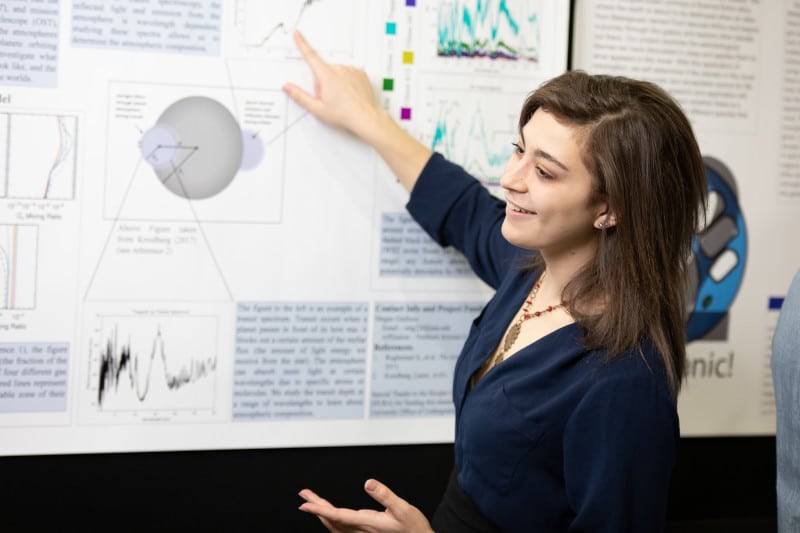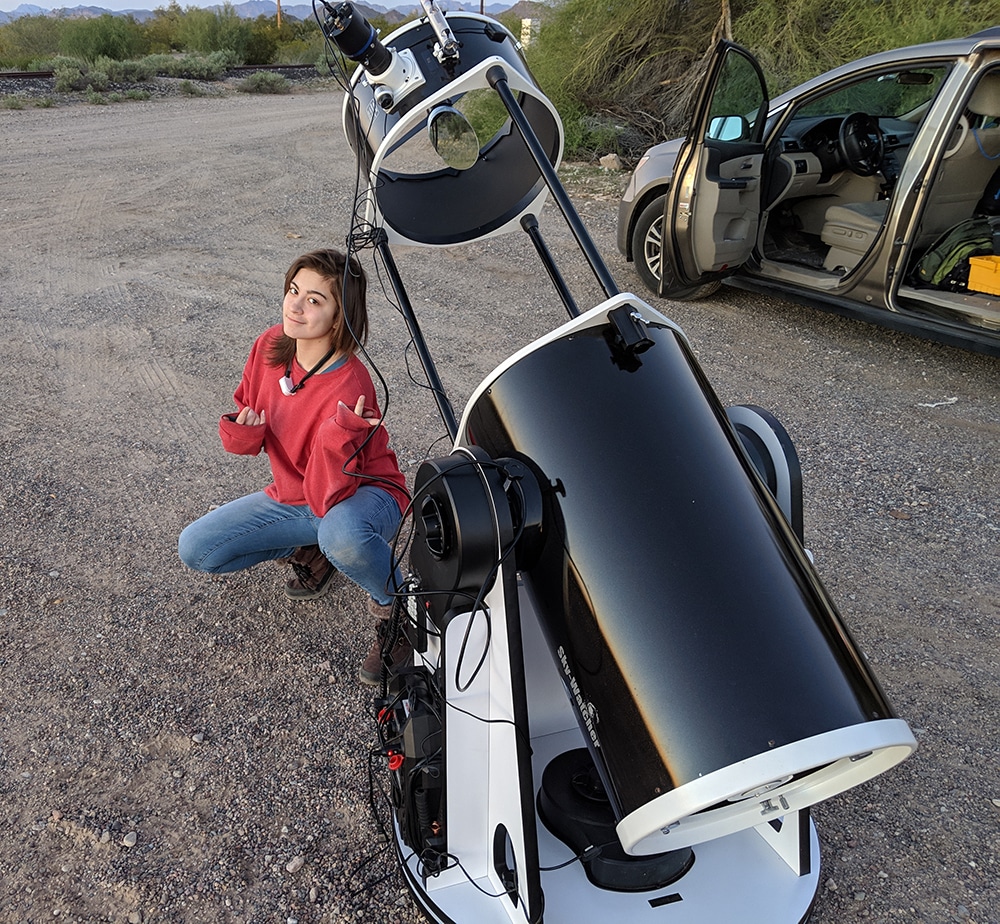As a first-year student at NAU, Megan Gialluca walked into astronomy professor Ty Robinson’s office, introduced herself and told him she was interested in doing research with him.
Four years later, she’s leaving NAU as a Goldwater Scholar and with three years of funding for a Ph.D. in hand as a recipient of the NSF’s Graduate Research Fellowship Program (GRFP) award.
Gialluca graduated in April with a degree in astronomy and has spent her NAU career focused on research and science education, including winning grants to run her own research projects, collaborating with a Harvard researcher to study dark matter and working at Lowell Observatory—an opportunity that helped get the New Hampshire student to NAU four years ago.
“It’s been a long road,” said Gialluca, whose next stop is the University of Washington for a Ph.D. in astronomy and astrobiology. “It’s very much a sum of a lot of hard work and advising, which is why you should just ask. You will be surprised how many people will say yes to you.”
Gialluca’s doing the kind of research that affects everyday life—but most people don’t know how or why it affects them. Her research with Robinson has been focused on looking for habitability indicators or biosignatures—evidence that other planets could host life or had hosted life at some point in the past. It’s a question that has fascinated many for decades.
She’s also interested in near-Earth objects and where these objects originate, she wants to get people as excited about the night sky as she is, and then there’s still the matter of dark matter, which makes up most of the universe.
“I would like to know more about what makes up most of the universe,” Gialluca said. “Dark matter is intimately tied to how the universe will eventually end. I think it would be nice to have an idea of where all this is headed.”
Transit spectroscopy research
Transit spectroscopy is the science of gathering data from the passage of a celestial object as it passes in front of a star. As an object moves in front of a star, light from that star passes through the planet’s atmosphere which can be used to determine what gases are present there. Knowing what gases exist on a planet is a critical component to tracing biosignatures, or the possibility of some form of life on that planet.
But her research isn’t just looking at what’s there. It’s looking at what a researcher would expect to see when looking through the lens of the James Webb Space Telescope (JWST)— planned to succeed the Hubble Space Telescope as NASA’s flagship astrophysics mission sometime this year. Gialluca collected enough data to write a Python program to create a model. She tells the program what’s in the atmosphere, and then it tells her how the data she provided, which is ideal and very detailed, would look through the lens of the JWST—it degrades “perfect” data to what JWST would see, including uncertainties such as light from the sun, broken pixels on the telescope and other potential points of distraction. It will help researchers figure out where to point the JWST to make better use of their telescope time.
This data is critical because right now, all astronomers throughout the world will use the JWST to track any number of objects, including exoplanets, so time on the telescope is “super, super, super valuable and really hard to get,” and researchers want to be able to say exactly where they’re looking and what they expect to find. Current models show what the exoplanet atmospheres should look like; Gialluca’s model helps researchers predict what they will see with all the noise.
Given the vastness of space and the sheer number of variables researchers have to consider, adding a little predictability can go a long way.

“In this scenario, I have a model that already tells me what’s in the atmosphere, and the code returns to me what the JWST would see and what the atmosphere would look like to astronomers,” she said. “My code degrades the data to what the JWST would realistically observe. My work is going to be super useful for people who want to observe transits of planets with JWST and will help researchers argue that it’s worthwhile for them to get JWST time to observe a system because they’ll be able to see it in these conditions.”
The years of work on this project paid off in Gialluca’s final months at NAU; in March, it was accepted for publication in Astronomical Society of the Pacific.
The enigma of dark matter
The summer before her senior year, Gialluca did an NSF-funded Research Experience for Undergraduates (REU) program “at” the Harvard Center for Astrophysics, though the pandemic kept her in Flagstaff. She worked with Ana Bonaca, a postdoctoral scholar at Harvard, to study dark matter, the mysterious substance that makes up most of the universe but about which scientists have vanishingly little knowledge, and stellar streams, which are long, thin streams of stars that are created when satellites of the Milky Way like globular clusters are tidally disrupted (pulled apart by the galaxy’s gravity).
Bonaca was originally looking at structures called stellar streams, which are created when a globular cluster (a big cluster of stars or a dwarf galaxy) is disrupted by title forces. This means that gravity acts more on parts of the stream that are closer to the sun, which pulls harder on some parts of the cluster than others and shifts the cluster into a long, thin stream. These streams also are quite sensitive to galactic forces, including mass, gravitational potential and dark matter.
With that last variable, the mystery deepens.
“There are big questions with dark matter—does it exist in clumps in the galaxy?” Gialluca said. “How much is the mass of a dark matter particle? And can we use stellar stream observations to inform us on what a mass of single dark matter particles would be?”
Combining what they know about dark matter—very little—with what they know about stellar streams, Bonaca and Gialluca looked at the velocity of stars in the stellar stream and how much they deviated from their orbit. This velocity dispersion (the movement along the Y axis as the star moved on the X axis) is affected by the mass of the Milky Way and other factors that come into contact with the stream—factors like dark matter particles, which are hypothesized by some to exist in clumps scientists refer to as dark matter sub-halos. If these particles exacerbate the star’s velocity, that could help them estimate the mass of a dark matter particle.
Using Python modeling, they came up with an estimate for that mass. That estimate was three magnitudes below the lower limit of what that mass could be, so obviously, Gialluca said, their estimation was incorrect.
“But in science, even when you fail, that’s usually an opportunity to learn something new,” she said. “Instead of estimating mass, our overarching goal was to present a well-constrained velocity dispersion measure of this stream (the GD-1 stream) and provide evidence that the stream has been perturbed by an outside object.”
Their research showed that something had affected those streams, which meant particles were interacting with the stars.
“If you account for all of the possible heating sources in the stream and the velocity disruption is still too small, it either means the dark matter model isn’t working or there are other things that have caused the velocity to get larger that we haven’t considered,” she said. “There’s something else going on in the stream and we don’t know what it is.”
Science outreach at Lowell Observatory
Gialluca also has astronomy work that is a little closer to home—literally. Like many NAU astronomy students, she worked at Lowell Observatory while she was here. She started as a public program educator, offering tours and running telescope programs in the evening. Halfway through her junior year, she was promoted to research assistant, helping astronomer Nick Moskovitz on a five-year NSF-funded project, LOCAMS, with the goal of capturing every meteor that shoots through the Arizona sky.
“The end goal of this is to have complete coverage of Arizona and parts of New Mexico,” she said. “Anytime anyone is outside camping and they look up and see a super cool meteor go across the sky, we’ve observed it. At least one camera has seen that and recorded it for us.”
It’s big data at work, she said. With low-cost security camera systems installed at sites throughout the state, including Sedona, Prescott, Window Rock, Happy Jack, Flagstaff and others, they should be able to capture everything out there, which can range from a couple hundred to 500 or 600 meteors a night during a meteor shower. Besides simply capturing them in the sky, the camera systems should allow the researchers to determine if meteors dropped any rocks or where they are likely to be, so they can retrieve the rocks quickly.
“If we can go get them within a couple of days, we know it’s fresh, it just came from space and it hasn’t been subjected to Earth’s process that might make it less useful,” she said. “Our dream would be a giant meteor coming in that we observed, we see that it dropped rocks, we’re able to retrieve the rocks and we’re able to look at the orbit and identify the parent body of the meteor.”

In addition to setting the cameras up, Gialluca is helping to create and populate the database where all of this information is living. They want that database to constantly update so someone who sees a meteor one night can check it the next day and learn more about it. That remains an ongoing process, she said.
Her work at Lowell played a significant role in her GRFP application; the NSF looks for educational outreach efforts among applicants, as bringing science to non-scientists in an interesting, informative way is an important part of the organization’s mission. It’s important to Gialluca too, as the science she’s participating in affects society in so many ways that people often don’t consider. Knowing the history of habitability on Mars or Venus, for example, could be an indicator of Earth’s future or its past. The happenings in the galaxy aren’t quite as far, far away as people believe and have greater effects on Earth than most of us understand. And dark matter, though it’s an enigma, is, quite literally, everywhere.
Applying for the GRFP
Undergraduate students are allowed to apply twice: once as a senior moving into graduate school and once as a graduate student. Gialluca went into the process expecting it to be a good practice run for next time.
Instead, she woke up one day in March to find her phone buzzing with emails, including one from Robinson telling her she had some mail from the NSF. She hadn’t even decided where she was getting her Ph.D. when she found out she received the funding.
The GRFP is a research grant, but research is not the only factor the NSF considers. The application asks about outreach and science education and asks scholars to talk about their own life stories. Gialluca talked about her life goals, her interests, the broader impact she wanted her work to have and her college career—and, of course, her research, leading with the day she walked into Robinson’s office, introducing herself and asking to work with him in one breath.
“Extremely few freshmen possess the self-confidence and personal vision required to solicit research opportunities shortly after arriving on campus,” Robinson wrote in his letter to the NSF recommending Gialluca. “Megan arrived with a copy of an independent research study report from high school and ready to answer questions, and she was able to clearly state plans for her research in my group.”
Gialluca’s initiative continued to impress Robinson; she jumped into learning Python coding, applied for funding, first from NAU and then NASA to lead her own projects, then earned a Goldwater Scholarship as a sophomore. He saw the same drive and organization as she worked through her research projects, which played a significant role in getting publishable results.
“Megan is clearly on the path to research greatness,” he said. “Few times in our lives do we meet young people where we think, ‘this person is really headed somewhere!’ That was my initial reaction to meeting Megan, and I am now even more certain of this assessment.”
Editor’s note: Six NAU students were selected for the National Science Foundation’s Graduate Research Fellowship Program. Read about their research.
Jessica Archibald: Managing mangroves: GRFP recipient Jessica Archibald studies social-ecological approaches to forest restoration
Jonathan Chin: Building a better solar panel: NAU graduate wins NSF award to continue research into sustainable energy
Ethan Taber: Two years after Museum Fire, NAU grad student looks at what slow regeneration of fire site could mean for the future
Heidi Toth | NAU Communications
(928) 523-8737 | heidi.toth@nau.edu




